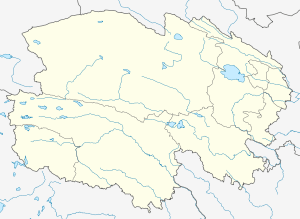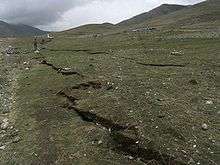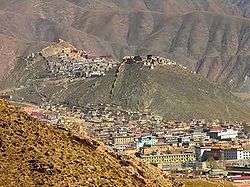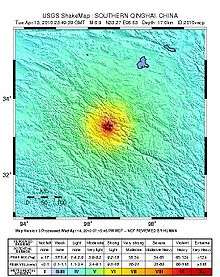2010 Yushu earthquake
 Gyêgu | |
| Date | 14 April 2010 |
|---|---|
| Magnitude | 6.9[1]Mw or 7.1[2] Ms |
| Depth | 10 km (6 mi) |
| Epicenter | 33°16′16″N 96°37′44″E / 33.271°N 96.629°ECoordinates: 33°16′16″N 96°37′44″E / 33.271°N 96.629°E |
| Areas affected | People's Republic of China |
| Casualties |
2,698 confirmed dead[3][4] 12,135 injured 270 missing |
| Wikinews has related news: 6.9 magnitude earthquake hits western China |
The 2010 Yushu earthquake struck on April 14 and registered a magnitude of 6.9Mw[5][6] (USGS, EMSC) or 7.1Ms[2][7] (CEA, CENC). It originated in Yushu, Qinghai, China, at 7:49 am local time.[1][8] According to the Xinhua News Agency, 2,698 people have been confirmed dead, 270 missing, and 12,135 injured of which 1,434 are severely injured.[4] The epicenter was located in Rima village (日玛村/日麻村), Upper Laxiu township (上拉秀乡) of Yushu County,[9][10] in remote and rugged terrain, near the border of Tibet Autonomous Region. The epicenter is about 30 km from Gyêgu town or Jyekundo, the seat of Yushu County,[11] and about 240 km from Qamdo.[5] The epicenter was in a sparsely populated area on the Tibetan plateau that is regularly hit by earthquakes.[12]
The 12th century Thrangu Monastery and surrounding villages were severely damaged and many monks and villagers were killed.[13]
Geology

Qinghai lies in the northeastern part of the Tibetan Plateau, which formed due to the ongoing collision of the Indian Plate with the Eurasian Plate. The main deformation in this area is crustal shortening, but there is also a component of left lateral strike-slip faulting on major west–east trending structures such as the Kunlun and Altyn Tagh fault systems that accommodate southeastward translation of the Tibetan area.
The earthquake occurred on the Yushu fault,[14] about 300 kilometres (186 mi) south of the Kunlun fault.[5] The Yushu fault forms part of the Yushu-Garzê-Xianshuihe fault zone (玉树-甘孜-鲜水河断裂带),[15] one of the most active fault zones in eastern Tibet.[16] In history, many earthquakes greater than magnitude 7 have occurred in the Xianshuihe fault zone,[15] for example, the magnitude 7.25 earthquake in the Luhuo area on March 24, 1923, and the Ms 7.6 earthquake on February 6, 1973 in Luhuo.[17] Almost all sections of the Xianshuihe fault zone have produced strong earthquakes in records, except the sections of Yushu and Shimian (石棉). However, a trace of a strong earthquake occurred about 16,000 or 17,000 years ago has been found in Shimian. Hence, the Shimian section of the Xianshuihe fault zone is speculated to be currently locked and have the possibility of producing a strong earthquake in the future.[15]
Damage

In Qinghai, building damage was reported with no casualties in the counties of Zadoi, Nangqên, and Qumarleb of Yushu Prefecture.[18] At least 11 schools were destroyed in the earthquake.[19] Over 85% of buildings in Gyegu, mostly of wood-earth construction, were destroyed, leaving hundreds trapped and thousands homeless.[9] A vocational school collapsed and trapped many students.[9] Power outage was also reported in Gyêgu.[20]
In Sichuan, strong shaking could be felt in the counties of Sêrxü, Dêgê, and Baiyü, Garzê Tibetan Autonomous Prefecture. Road damage was reported in Sêrxü County.[21]
Due to the rough terrain and the fact that landslides have destroyed the local infrastructure, the initial rescue operations were undertaken by the People's Armed Police and People's Liberation Army soldiers of Lanzhou Military Region.[22] The Qinghai provincial government said in a public statement that five thousand tents, 100,000 thick, cotton coats, and heavy blankets were being sent to help survivors cope with the strong winds and near-freezing temperatures of around 6 °C (43 °F).[23]
The Yushu Batang Airport was re-opened at noon on Wednesday, April 14, and the first flight with personnel and supplies of the China International Earthquake Rescue Team landed there at 8 pm.[24]
The Changu (禅古) Dam, located on the Batang River (巴塘河; a right tributary of the upper Yangtze River) some 15 km upstream from the Yushu County seat (apparently at 32°54′40″N 97°02′50″E / 32.91111°N 97.04722°E),[25] was damaged by the earthquake. Chinese language news reports as translated in a press release from the International Rivers stated that it is "at the risk of collapse at any time."[26]
Response
| Wikinews has related news: Rescue efforts underway after China earthquake |
Chinese President Hu Jintao and Premier Wen Jiabao urged all-out efforts to help rescue those affected by the earthquake. Several hours after news of the quake broke, Vice Premier Hui Liangyu was sent to the region to oversee rescue efforts.[27][28] Some 3,700 personnel from the Qinghai division of the People's Armed Police was sent to the region to aid in rescue efforts. Specialty personnel also arrived from neighbouring provinces Gansu, Shaanxi, and Ningxia, as well as the Tibet Autonomous Region.[29]
President Hu Jintao was in Brazil at the time and decided to cut short a state visit and BRIC summit and rush back to China to co-ordinate rescue efforts. He also postponed his upcoming tour to Venezuela and Chile. Premier Wen Jiabao arrived in Yushu on April 15 to lead rescue work, and postponed his trip to southeast Asia.[30] Hu arrived in Yushu three days after Wen, to help guide the relief efforts and console victims.[31]
Tribute and Day of Mourning

On the evening of April 20, a national evening gala was hosted on China Central Television.[32] The event, which drew many celebrities and a large viewership, raised some 2.2 billion yuan ($US 322 million), which exceeded the amount raised in a similar gala for the Sichuan earthquake.[33] April 21 was declared a national day of mourning, reminiscent of a similar event in the 2008 Sichuan earthquake. At Zhongnanhai, President Hu Jintao led a minute of silence, alongside the entire Politburo Standing Committee. Newspapers printed in black and white, and all major websites also changed their home page to black and white to reflect the grave mood.[33] Qiang Wei, CPC Party chief of Qinghai, led a large ceremony in Xining; a minute of silence was observed across the entire province, when police sirens and horns sounded.[34]
During the National Day of Mourning, all public entertainment activities were cancelled, and all state-run networks as well as some provincial networks redirected their regular programming to non-stop earthquake coverage.[35] The National Mourning sparked public debate about civil rights on Chinese web forums. The programming particularly irritated football fans, who complained that UEFA Champions League coverage of the Barcelona vs. Inter Milan match was replaced by earthquake coverage, accusing the authorities of being overly concerned with appearances.[35]
City University of Hong Kong professor Zheng Yutou opined that the "Day of Mourning" reflected China's political values - that collective interests and values outweigh those of individuals. Zheng said that this was diametrically opposed to the emphasis on individualism in Western countries. Zheng believed that a top-down public directive for the country is a reflection that without democracy, a formal Day of Mourning is one of a few ways to show that the leadership is concerned about the welfare of the people.[35] A South China Morning Post article said the event was an attempt to distract the public from other ongoing social problems. Yuan Weishi, retired professor at Sun Yat-sen University, disagreed with the assessment that the Day of Mourning should be seen as a political event. He said that the event is not at all surprising given the circumstances, and that there is no real threat to civil liberties.[35] Yuan said that "politicizing the situation makes it needlessly tense". Duowei added that National Days of Mourning have been held in many countries for large natural disasters and emerging as the "international norm".[35]
Role of monks and victims' rites
According to television reports filed by Chen Xiaonan of Hong Kong's Phoenix Television, and the Associated Press, thousands of Tibetan monks were active in the search and rescue for quake victims buried in the rubble, and were successful in the retrieving of buried yet still alive victims, as well as the retrieving of dead bodies and the subsequent conducting of traditional Tibetan sky burial or mass cremation.[36][37]
Monks provided spiritual services and consoling for families of the victims, and performed burial rites. Due to the great number of ethnic Tibetan victims in the quake, local clergy from monasteries said that the traditional sky burial funeral rites would be too difficult to manage, and that the unsanitary conditions meant that the souls of the departed may not reach heaven. A local monk said that it was determined a mass cremation, presided over by local Buddhist monks, would be the most appropriate funeral rite for the victims.[38] The Qinghai provincial Department of Civil Affairs sent out directives that funeral customs for local ethnic minorities must be respected, that the victims themselves must be treated with respect, and for a DNA bank to be set up for bodies who have not yet been identified.[38]
Reports later surfaced in Western media that groups of monks were also asked to leave the disaster area via telephone by local authorities. One monk said that the government may have been concerned about their safety.[39]

External aid
On April 18, the Republic of China (Taiwan) Red Cross Society send a 20-member medical team, composed of volunteers who have extensive experience with first aid and emergency procedures in earthquake and flooding rescue missions, to Qinghai province earthquake area, together with one tonne of medicine and equipment. “We tried to send more supplies but there was not sufficient airlift capacity in the disaster area,” an ROC Red Cross Society spokesman said.[40]
The American Red Cross has sent an initial sum of $50 000 in relief funds to help affected families in the Qinghai Province.[41][42] Many countries and organizations around the world sent condolences and pledged assistance if necessary.[43][44][45] The Artistes 414 Fund Raising Campaign was held at the Hong Kong Coliseum on April 26, 2010.
High altitude sickness
Since Yushu is located at 4000 meter high altitude when concentration of oxygen is much thinner than that at sea level, many rescuers who come from low land have fallen ill due to high altitude sickness, as 300 Guangdong rescuers were forced to be evacuated into lower altitude area, and one Chinese reporter was confirmed dead due to pulmonary complications caused by lack of oxygen.[46]
Political issues
The earthquake occurred in a Tibetan region in Qinghai province, where 93% of the local population is of Tibetan ethnicity, and many locals do not speak or understand Mandarin Chinese, and the community was home to large numbers of Tibetan Buddhists. A New York Times editorial wrote that while the death toll was small compared to the Sichuan earthquake in 2008, the rapid mobilization and highly organized relief effort "underscored the Communist Party’s determination to rally the nation and transform the disaster into a showcase of its benevolence and resolve", as well as an opportunity to showcase ethnic unity and a "softer side" of the government, who is often seen as being at odds with the Tibetan population.[47] State-run English newspaper China Daily praised the work of monks in two separate stories,[48][49] while also stressing the re-building of temples in the region.[49] In addition, state media avoided mention of schools that may have collapsed during the quake, with fresh memories of the public and foreign media backlash from a school construction scandal in Sichuan.[47]
There were earlier rumours that the authorities were attempting to hide the extent of the damage caused by the earthquake. In response, Guo Weimin of the State Council Information Office responded that "all the information coming out of the disaster zone has been accurate, timely, transparent... we will not, have not, and have no reason to alter any of the statistics regarding fatalities."[50] News reporting has also been relatively open; foreign media have been reporting in the area without government interference. In addition, bloggers and independent journalists were also allowed to report in the area, although more "sensitive" issues such as ethnic relations and religion face restrictions.[47] Tibetan activist Woeser acknowledged that the government's relief efforts have been robust, but remarked that relief funds risk embezzlement from local officials.[47] In regards to the authorities declining entry of foreign personnel to the region, the National Ministry of Defence stated that the terrain in Qinghai is rough and that funding and personnel have been largely sufficient for the relief efforts, and that foreign organizations could contribute through monetary donations.[51]
List of aftershocks
The initial earthquake was preceded by a foreshock and followed by several aftershocks, four above magnitude 5, including a M5.8 aftershock at a 4 km (2.5 mi) depth on April 14.[52]
Officials have warned that aftershocks above magnitude 5.5 are likely to continue,[53] and the China Earthquake Networks Center warned that further aftershocks above magnitude 6 are likely for several days following the main earthquake.[54]
Only shocks with magnitude 4.0 or higher are listed. Shocks with magnitude 5.5 or higher are highlighted in light blue. The main shock with moment magnitude 6.9 Mw[1] is highlighted in dark blue.
| Date (YYYY-MM-DD) | Time (UTC) | Latitude | Longitude | Depth | Magnitude |
|---|---|---|---|---|---|
| 2010-04-13 | 21:40:00 | 33.183° N | 96.623° E | 18.9 km (12 mi) | 5.0 (Mw) |
| 2010-04-13 | 23:49:39 | 33.224° N | 96.666° E | 17.0 km (11 mi) | 6.9 (Mw) |
| 2010-04-14 | 00:01:17 | 32.875° N | 96.999° E | 10.0 km (6 mi) | 5.3 (Mw) |
| 2010-04-14 | 00:12:25 | 33.159° N | 96.580° E | 10.0 km (6 mi) | 5.2 (Mw) |
| 2010-04-14 | 01:25:15 | 33.179° N | 96.448° E | 4.0 km (2 mi) | 5.8 (Mw) |
| 2010-04-17 | 00:59:01 | 32.588° N | 92.743°E | 40.6 km (25 mi) | 5.1 (Mw) |
See also
References
- 1 2 3 "Magnitude 6.9 – SOUTHERN QINGHAI, CHINA 2010". USGS. April 14, 2010. Archived from the original on 15 April 2010. Retrieved 14 April 2010.
- 1 2 About 400 dead, 10,000 injured in 7.1-magnitude quake in China's Qinghai, xinhuanet.com. Retrieved 14 April 2010.
- ↑ http://news.xinhuanet.com/english2010/china/2010-05/31/c_13325439.htm
- 1 2 "China to mourn quake dead, public entertainment to be suspended". Xinhuanet. Xinhua News Agency. 2010-04-20. Archived from the original on 23 April 2010. Retrieved 2010-04-20.
- 1 2 3 "Magnitude 6.9 – SOUTHERN QINGHAI, CHINA". earthquake.usgs.gov. 2010-04-14. Archived from the original on 17 April 2010. Retrieved 2010-04-15.
- ↑ "EMSC – European-Mediterranean Seismological Centre". Emsc-csem.org. Archived from the original on 17 April 2010. Retrieved 2010-04-15.
- ↑ China Earthquake Network Center
- ↑ "兰州军区和武警部队官兵投入青海玉树抗震救灾 Xinhua.net 14 April 2010". News.xinhuanet.com. Archived from the original on 17 April 2010. Retrieved 2010-04-15.
- 1 2 3 "BBC 中文网 – 兩岸三地 – 青海玉樹地震已造成至少400多人死亡". Bbc.co.uk. Archived from the original on 16 April 2010. Retrieved 2010-04-14.
- ↑ "815 郵政編碼(郵遞區號)查詢 – 郵編庫(繁體)" (in Chinese). Postcode.jamesqi.com. 2010-02-26. Retrieved 2010-04-14.
- ↑ "青海玉树地震造成人员伤亡 州府结古镇民房倒塌严重_新闻中心_洛阳网". News.lyd.com.cn. Archived from the original on 2011-05-13. Retrieved 2010-04-15.
- ↑ Michael Bristow (14 April 2010). "China earthquake kills hundreds in Qinghai". BBC World. Archived from the original on 17 April 2010. Retrieved 14 April 2010.
- ↑ http://www.konchok.org/earthquakeinTibet.htm
- ↑ Earthquake Research Institute (2010-04-15). "Qinghai Earthquake, China, 2010". Archived from the original on 18 April 2010. Retrieved 15 April 2010.
- 1 2 3 http://ngmchina.com.cn/web/?viewnews-163319[]
- ↑ Shifeng, W.; Erchie W., Xiaomin F. and Bihong F. (2008). "Late Cenozoic Systematic Left-Lateral Stream Deflections along the Ganzi-Yushu Fault, Xianshuihe Fault System, Eastern Tibet". International Geology Review. 50 (7): 624–635. doi:10.2747/0020-6814.50.7.624. Retrieved 2010-04-15.
- ↑ http://www.csi.ac.cn/manage/html/4028861611c5c2ba0111c5c558b00001/zhenli/liuying/zhenli/html/zhenli007.htm
- ↑ "玉树公用设施倒塌不多 救援大多靠手刨进展缓慢-搜狐新闻". News.sohu.com. 2010-02-04. Archived from the original on 19 April 2010. Retrieved 2010-04-15.
- ↑ "中國‧11學校毀‧師生被埋‧逾66學生罹難 | 星洲日報". Sinchew.com.my. Archived from the original on 17 April 2010. Retrieved 2010-04-15.
- ↑ "独家连线:玉树结古镇断水断电 村民积极自救_资讯_凤凰网". News.ifeng.com. Archived from the original on 18 April 2010. Retrieved 2010-04-15.
- ↑ "大公網". Takungpao.com. Retrieved 2010-04-14.
- ↑ "青海7.1级地震 武警驻青海3000余兵力投入抢险 Xinhua.net 14 April 2010". News.xinhuanet.com. 2010-03-30. Archived from the original on 17 April 2010. Retrieved 2010-04-15.
- ↑ PTI (14 April 2010). "Strong quake in western China's Qinghai kills 300". The Hindu. Beijing. Archived from the original on 17 April 2010. Retrieved 14 April 2010.
- ↑ Airport vital lifeline to relief effort. By Xin Dingding (China Daily), 2010-04-15
- ↑ 青海玉树禅古电厂水库震后出现裂缝 ("Cracks appeared in the [Dam of] the Reservoir of the Changu Power Plant in Yushu, Qinghai"); published in 汉网-武汉晚报, 2010-04-15
- ↑ "The Qinghai Earthquake and Dams" Archived April 17, 2010, at the Wayback Machine., International Rivers. Retrieved 14 April 2010.
- ↑ "China's Hu, Wen urge all-out efforts to save people in quake-hit zone". News.xinhuanet.com. Archived from the original on 19 April 2010. Retrieved 2010-04-14.
- ↑ "Hundreds feared dead in Chinese earthquake", CNN World. Retrieved 14 April 2010.
- ↑ 青海玉树已开展自救 周边四省区派队增援 (in Chinese). Netease. Archived from the original on 17 April 2010. Retrieved 22 April 2010.
- ↑ Romana, Chinto; Clarissa Ward, Beth Lloyd (2010-04-15). "Rescuers Face Tough Conditions In China Quake Zone". Qinghai: ABC News. Retrieved 15 April 2010.
- ↑ "President Hu arrives in quake-hit Yushu to direct relief work". Xinhua. 2010-04-18. Archived from the original on 20 April 2010. Retrieved 2010-04-18.
- ↑ "2010-04-20-央视情系玉树,大爱无疆,抗震救灾,大型募捐晚会". Archived from the original on 2013-07-05. Retrieved 2013-07-01.
- 1 2 Moore, Malcolm (2010-04-21). "China mourns victims of Yushu earthquake". London: Daily Telegraph. Archived from the original on 24 April 2010. Retrieved 21 April 2010.
- ↑ Tran, Tini (2010-04-21). "China mourns 2,064 victims in devastating quake". Associated Press. Archived from the original on 24 April 2010. Retrieved 22 April 2010.
- 1 2 3 4 5 "全國哀悼引发中國公民權利爭論 (National Mourning sparks civil rights debate)" (in Chinese). Duowei. 2010-04-21. Archived from the original on 24 April 2010. Retrieved 22 April 2010.
- ↑ 陈晓楠 (2010-04-21). "凤凰卫视 冷暖人生 陈晓楠 情感". 凤凰卫视. Retrieved 22 April 2010.
- ↑ "Raw Video: Tibetan Monks Help China Quake Rescue". Associated Press. April 16, 2010. Retrieved 22 April 2010.
- 1 2 "青海玉树地震死难者集体超度火化". BBC Chinese. 2010-04-17. Archived from the original on 20 April 2010. Retrieved 21 April 2010.
- ↑ Tran, Tini (2010-04-10). "China mourns 2,064 victims in devastating quake". The Seattle Times. Associated Press. Retrieved 2010-08-28.
- ↑ "Taiwan's quake rescue team arrives in Qinghai". Taiwan Today News. April 21, 2010. Retrieved 21 April 2010.
- ↑ "Wednesday 14Apr2010 Red Cross Sends $50,000 To China After Quake". Basil & Spice. April 14, 2010. p. 1. Archived from the original on 17 April 2010. Retrieved 14 April 2010.
- ↑ "The American Red Cross Releases $50,000 to Help Families Affected by the Earthquake in Northwest China". The American Red Cross. April 14, 2010. p. 1. Archived from the original on 15 April 2010. Retrieved 14 April 2010.
- ↑ Pantea, Liviu (April 15, 2010). "China Earthquake Today: EU expresses condolences over victims in China". p. 1. Archived from the original on 19 April 2010. Retrieved 14 April 2010.
- ↑ "Bulgarian President Purvanov sends condolences to China after deadly quake". The Sofia Echo. April 14, 2010. p. 1. Archived from the original on 17 April 2010. Retrieved 14 April 2010.
- ↑ "Pope calls for solidarity after earthquake in China", Catholic News Agency, Retrieved 14 April 2010.
- ↑ "广东地震救援队面临高原反应被迫撤离". RFA. 2010-04-19. Retrieved 22 April 2010.
- 1 2 3 4 Jacobs, Andrew (2010-04-21). "An Official Mourning in China for Quake Victims". New York Times. Archived from the original on 24 April 2010. Retrieved 21 April 2010.
- ↑ Hu, Yongqi; Chen Jia (2010-04-24). "Monks offer crucial help to Yushu". China Daily. Archived from the original on 27 April 2010. Retrieved 26 April 2010.
- 1 2 "Repair of damaged temples a priority". China Daily. 2010-04-26. Retrieved 26 April 2010.
- ↑ State Council Information Office. "国新办:玉树地震信息发布及时公开透明". Xinmin. Retrieved 21 April 2010.; Chinese: "整個信息的发布是及時的、公開的、透明的,對媒體的采訪也是開放的,所以我想不會也不可能也没有必要去隱瞞死亡數字."
- ↑ "中國舉國哀悼玉樹地震遇難者 (China mourns victims of Yushu earthquake)" (in Chinese). Duowei. 2010-04-21. Retrieved 21 April 2010.
- ↑ Earthquake Hazards Program, USGS (April 14, 2010). "Magnitude 5.8 - SOUTHERN QINGHAI, CHINA". United States Geological Survey. Archived from the original on 15 April 2010. Retrieved 15 April 2010.
- ↑ Text Broadcast, National Turk (April 14, 2010). "West Central China – An earthquake estimated to be 7.1 magnitude has ripped through West-Central China killing at least 300 people and injuring thousands as rescue workers work against time to find survivors under collapsed buildings.". National Turk. Retrieved 14 April 2010.
- ↑ International News, UPI (April 14, 2010). "Nearly 600 dead, 10,000 hurt in quake". United Press International, Inc. UPI.com. Retrieved 15 April 2010.
External links
| Wikimedia Commons has media related to 2010 Yushu earthquake. |
![]() News related to Rescue efforts underway after China earthquake at Wikinews
News related to Rescue efforts underway after China earthquake at Wikinews
![]() News related to 6.9 magnitude earthquake hits western China at Wikinews
News related to 6.9 magnitude earthquake hits western China at Wikinews